The 8-string guitars belong to the electric type of guitars, having two more extra strings than classic 6-string guitars. The additional strings allow you to significantly expand the sound range or make a custom tuning. The best 8-string guitars have a powerful sound that suits for solo, riff, and even bass song playing. However, they are less popular than other guitars.
Due to the open 8 strings, the guitarist can easily create major and minor triads and other figures that go beyond the simple fifths and quarts. Additional strings minimize possible position changes during the playing, allowing you to span three full octaves within the same gamut. The 8-string electric guitar range gives access to combination chords that simultaneously include low and high notes. You can play chords on the first 4 strings (by 5-7 strings jamming), reinforcing their sound with a low 8th string. Most guitars have the body of the popular “stratocaster” shape. Such an instrument has convenient cutouts and 2 allocated “horns”.
The 8-string guitar as an instrument appeared in the XIX century. It was played by Italian musicians Luigi Legnani and Giulio Regondi. The specified guitar has become really popular in the “heavy” musical styles due to the Swedish Meshuggah band, which used this tool to create heavy riffs. It might be hard to choose the best 8-string guitar so it’s better to check out the following surveys of popular instruments and make the right decision.
8-String Guitar Reviews
Schecter OMEN-8
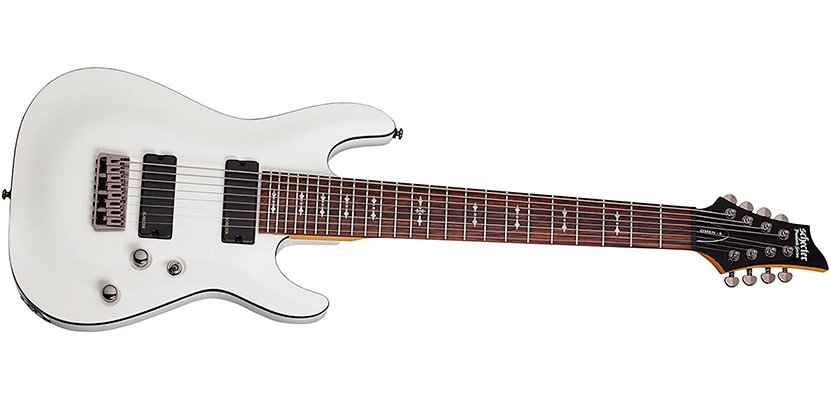
The neck of the Schecter OMEN-8 is made of maple, a stable material that is not much affected by the external environment. Maple conveys its bright tone to the body and complements its soft colors. The rosewood fretboard withstands constant contact with the fingers. The Diamond Plus pickups with ceramic magnets give a powerful signal that perfectly overloads the amplifier. These pickups were specifically designed for crunchy rhythm parts, fast-moving solos, and low tunes, so they help produce a sound that easily cuts through the mix. High-quality Schecter pegs provide smooth fine-tuning and pitch retention. The convex surface of the deck is one more attractive design feature. This cheap 8-string guitar has a warm, soft, and rich sound, strong attack, and versatility of sound. Its scale length is 26.5 inches, that’s a classic size for specified guitar type and is rather comfortable for keeping in hands.
Pros
- Two Duncan humbuckers give a deep sound.
- The ergonomic fretboard is comfortable for high-speed playing.
- Strings are fastened through the body. This allows the wood to resonate better and increase sustain.
Cons
- The white color body looks good, but all fingerprints on it and scratches are visible.
- The F# string is too high out of the box, so I have to adjust it manually.
Schecter Damien Platinum
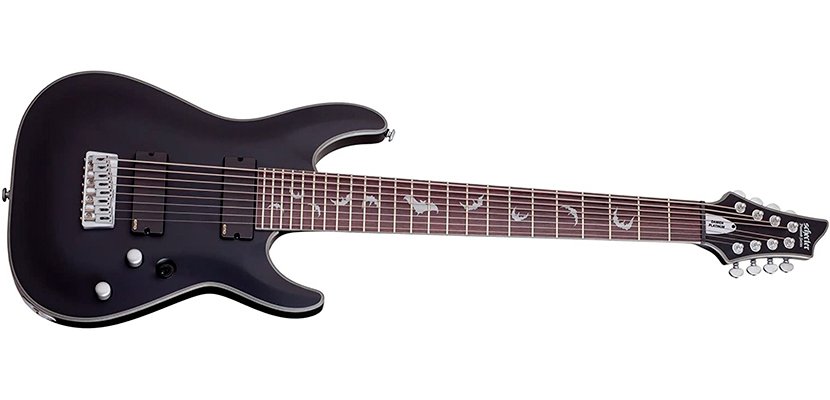
The Schecter 8-string guitar has a mahogany body that is considered as one of the best materials, as its timbre is characterized by deep bottoms and smooth tops. Open and soft pores provide great responsiveness and transmission of string vibrations. Maple neck feature includes focusing the energy of the strings and transferring them to the instrument deck. It’s reinforced with carbon fiber rods that make the neck sturdy. Tuning pegs provide stability and significantly accelerate the string replacement process. Pay attention that guitar’s scale is 28 inches, so it has a dense and confident bottom for 8 and 7 strings while maintaining the familiar feeling of guitar playing, without restricting articulation. It can boast two EMG 808 humbuckers due to which deep and pure tones appear. The EMG units do not flash and have a high output through the built-in preamplifier. The sound’s quality doesn’t change (there’s any muddiness) even after volume increases.
Pros
- There are no fingerprints on its satin black body.
- The fingerboard is decorated with a bat inlay instead of ordinary points that looks rather unique.
- The 18:1 ratio creates the conditions for a decent tuning.
Cons
- The guitar comes without a case.
- It’s only a right-handed modification, so the guitar might be not really comfortable for the left-handed musicians.
ESP LTD SC-608
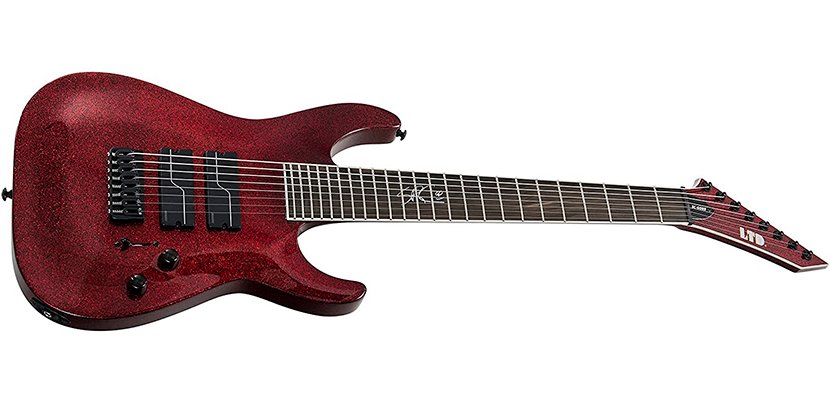
The LTD 8-string guitar is complemented with the neck-through mounting method. An instrument with such a fretboard (ebony) has good sustain, it sounds smooth and without dips across the entire frequency range. It is possible due to the fact that the fretboard itself occupies 1/3 of the guitar’s body. I feel a slight decrease in resonance at low frequencies. Since there is no heel on the neck, I can easily play favorite solos. The ESP LTD SC-608 body is made of mahogany, so its high density is able to give a very dense and rich sound without sagging. Two powerful, elongated active humbuckers are great for reaching the upper bass strings. It’s easy to get a good attack, a warm and even velvety enveloping sound. It has a classic 27 inches scale and is completely ready for studio or stage performances.
Pros
- The guitar has a 3-piece maple neck that positively influences on sound’s brightness.
- Its design (red color body with spangles) masks small scratches and stains.
- The instrument’s pickups have a distinctive and recognizable timbre.
Cons
- In a case of fretboard damage, its renovation requires significant financial costs.
- Mahogany is heavier than most analogs and this is also worth considering when choosing.
Schecter Hellraiser
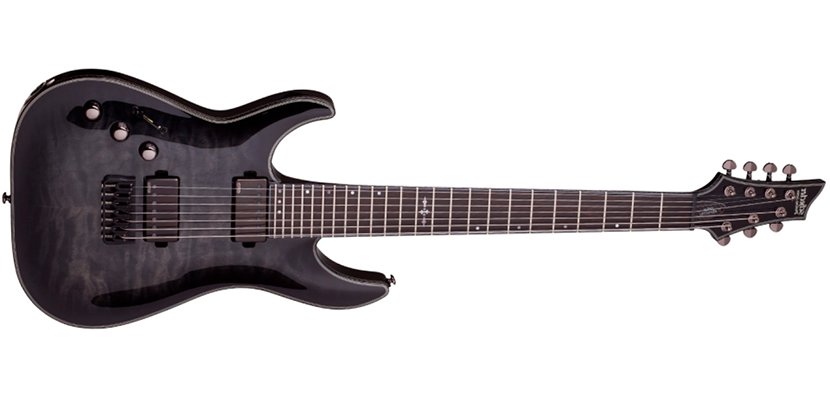
The Schecter Hellraiser 1925 is an 8-string electric guitar that contains quoteworthy features of Hellraiser and SLS models with a body made of mahogany. This material is rather heavy, but it adds low tone resonance and supplementary bass sounds. It facilitates resistance to scratching and denting, moreover, the mahogany warps pressure that the extra string exerts on it. The ebony fretboard has good resistance to loads and a high level of protection against moisture or temperature factors (ebony is famous for these characteristics). The neck is made of maple, which has a rigid structure and rather rugged character. It produces a sharp sound with a good attack. Its scale length is 28 inches that is an average exponent. The specified guitar comes with the hipshot hardtail bridge that provides the unit with impressive sustain potential and reasonably good string stability.
Pros
- The two-color option adds a “smoky” guitar effect.
- The instrument body has good durability due to overall density (according to general wood characteristics).
- The bridge pickup (the EMG 57-7H) is combined with the EMG 66-7H in the neck position and allows getting sound details at low and high tones.
Cons
- The glossy body surface can be easily covered with spots and fingerprints.
- White “horns” on the guitar are covered with small clefts, which on closer inspection look untidy.
ESP Guitars LJR208BLK
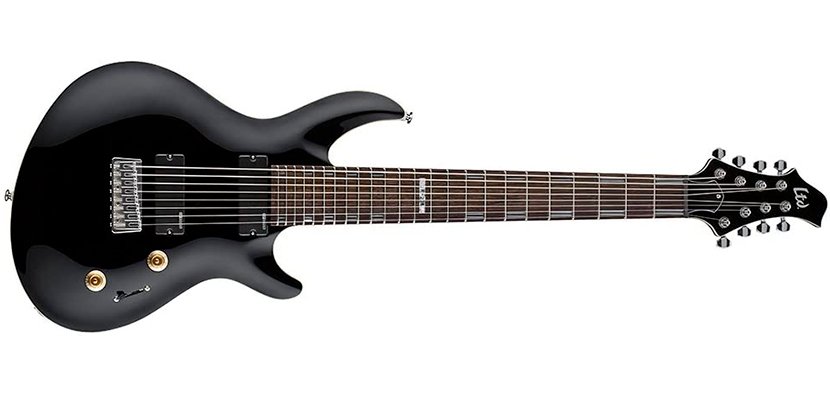
The ESP 8-string electric guitar has a basswood body, the softness of which affects the timbre of the instrument and its durability. A small resonance of the wood muffles the high frequencies and the sound becomes warm and dense in the middle. The low weight of the basswood is especially useful in the case of, for example, Floyd Rose Locking Tremolo on a guitar installing. The maple neck gives a specific high-frequency overtone. Rosewood fingerboard has a granular texture that allows guitarists to gain more control over the movement of the strings, especially in vibrato. The thin-U neck contour makes the playing process more convenient and reduces the load on the musician’s arms and shoulders. Despite all the positive moments, this instrument has not really good bolt-neck construction. The joints are bulky and it’s difficult to reach the upper registers. The scale length is 27 inches that is a comfortable variant for training and performances on the stage.
Pros
- It comes with the fixed bridge so the strings are kept in place.
- The pickups are designed specially by the ESP Company, so they are unique.
- The volume, tone, and three-position switch help you find the most suitable tones for each particular situation.
Cons
- The tuning keys are really sloppy, especially those ones on the lower strings.
- The F# string sounds muddy.
Buyer’s Guide
Things You Need to Consider Buying 8-String Guitars
It’s hard to call the eight-string guitar an easy-to-play instrument. It was made to push the limits of the owner’s musical talent and creativity. It might be hard to play classic sweet melodies on it, as this guitar is a good choice for metal and rock songs performing. If you really want to purchase it, you have to belong to one of the following categories.
- You know in practice how to play 6-string guitar and have a desire to move onto the next level.
- You get tired of 6-string guitar and want to retrain in the metal player.
- You already had the 8-string guitar and want to improve/replace the available musical instrument.
Cognize that most models are right-handed, but left-handed patterns are also presented in the current pipeline (they can be met quite rarely). 8-string guitars are supplemented with strings made of steel or nickel, moreover, steel ones give more clang sound, which adds some efficiency when playing heavy music.
It was made for metal
The guitar’s cutaways are much deeper, comparing with classic instruments. Such a peculiarity provides you with access to the length of the fingerboard. The 8-string guitar neck design can be different (“C” and “U” shapes) as the player has to feel comfortable. Pay attention that the djent sounds are spectacular and harsh while playing the 8-string guitar. This is about a musical technique, which is obtained from hitting the strings. Eight-string solo performances are usually played by tapping. Also, due to the unique timbre in the low register, any electric guitar effects sound deep.
What’s the difference of 8 string guitars?
A guitar with 8 strings has the following differences from the usual six-string guitars – this is about tuning with extra 2 strings down a quart. The ranges of these two guitars are along the same line, but the 8-string guitar is able to reproduce sounds below just one tone.
The differences are depicted in the following characteristics:
- By pickups. The instrument is equipped with high-output humbuckers. These 8-string pickups are used due to the increased number of octaves/sounds. The design of the sensors is based on the maximum output of powerful and low sound.
- By scale length. The eight-string scale is 26 to 29.4 inches long, which provides the tuning with greater stability. Some guitars have a small scale – this provides strong tension to the bass strings and weak on high frets. It’s possible to purchase a guitar with a scale similar to the six-string guitar with a length of 25.5 inches. Its characteristic feature is the presence of extra tension strings.
- By tuning. The standard tuning of the 8-string guitars is the following combination of sounds (from low to high): F#, B, E, A, D, G, B, and E. Such a ratio of sounds brings the specified guitar closer to the four-string bass: while the bass has the lower sound of the E1, the eight-string electric guitar has the lower sound – F#1. Those who prefer an even lower sonance can try the drop E. The extra-low harmonic fans can choose the double drop E system.
Length of the neck
Unlike a six-string guitar, which neck width is 1.69 inches, eight-string instruments are produced with necks of 2.16 inches wide. Manufacturers are actively working to improve the convenience of playing such guitars. Sometimes fanned fret on 8-string guitars are set not perpendicular to the neck of the instrument, but at an angle – due to this, guitarists do not feel any inconvenience along the entire fretboard length and isn’t limited in speed of movement over frets.
The 8-string instrument neck is much thicker and wider than the neck of a regular 6-string guitar that may lead to some uncomfortable feeling at the beginning of the training, but it all depends on the player and can be perceived as a self-challenge.
Pros & Cons
Pros
- The 8-string guitars have a bigger tonal range (comparing with 6 and 7-string guitars).
- Lower tunings are deep and strike into the marrow.
- They fit for playing the same melodies you played on 6 and 7-string guitars.
- The assembly quality is much higher than the 6-string instruments have.
Cons
- Big necks might be not really comfortable for some players.
- The versatility of eight-string guitars (models) isn’t wide enough.
- Some 6-string songs will sound a little bit awkward even on the best 8-string guitars (shifts in tonality can be perceived by the ear extremely unusual).

Hi everyone! I’m Thomas Moody, also known as Guitarzan.
